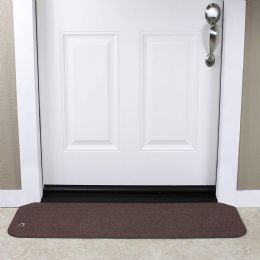Threshold ramps are available in all shapes, sizes, and colors, but most are designed to accomplish basically the same function, so selecting one is mostly based on features like weight capacity, size, and color. Additionally, it’s important to consider the material the ramp is made from and whether you will be using it for an indoor or outdoor threshold.
Weight Capacity
When selecting a ramp, weight capacity is one of the most important considerations in that it’s the feature that most determines safety. Ramps should always accommodate the weight of the intended user plus their device along with a nice 10-15 pounds of headroom at the very least.
Size
Another important feature to consider when shopping for a threshold ramp is the size. Measurements should be taken carefully to ensure not only that the ramp will fit within your space, but also that it will provide a safe, smooth transition with no risky bumps or gaps that could cause a potential accident.
Material & Color
Threshold ramps are most often constructed of lightweight aluminum, non-slip rubber, or durable woven recycled plastic. They are available in a variety of colors to either blend in or stand out from the floor, depending on whether visibility is a concern for the user or not.



.jpg&newheight=260&quality=80)







.jpg&newheight=260&quality=80)

These ramps are a great solution to small barriers like uneven thresholds and raised landings, but make a big difference to ease of access for users of mobility devices. Even the slightest 1-inch rise in a doorway threshold can be a major obstruction for a wheeled device or a user with limited mobility, and threshold ramps are a convenient and easy solution to this problem.
Threshold ramps are available in a variety of different sizes, shapes, and materials to accommodate the needs of any user and fit easily into any setting, decor, or environment both indoors and outdoors. The small size makes them a cost-effective and often easy-to-install solution for a variety of uneven floor and terrain access difficulties.